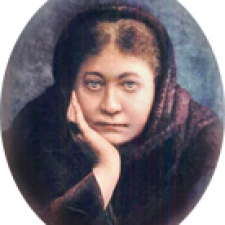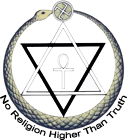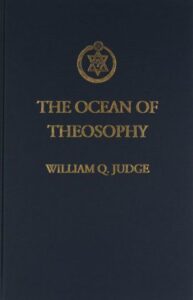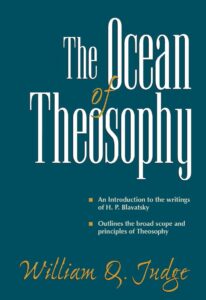Studies In The Ocean Of Theosophy Part VIII
Theosophy Magazine
Vol. 21, No. 8, June 1933
pages 363-368
Part VIII
CHAPTER five takes up general consideration of the two lower Human Principles. The discussion opens with a peculiarly blunt statement, evidently designed for those who, completely identifying themselves with body, make the physical encasement their “god” — “meaning it only when they say ‘I'”; and especially for such as are so enamored of physical charm as to make the material vesture “an object of exclusive care.” For such delusions, Mr. Judge here acts as spiritual surgeon performing an exploratory operation: with mental scalpel and forceps, he raises the delicate integument from the alluring image and reveals “a mass of flesh, bones, muscles, nerves, brain matter, bile, mucus, and blood.” Who would care to identify himself with these and mean these only when he says “I”? Well knew the Teacher that little else than contour, texture, and coloring are regarded when Self imagines itself to be Body. “Man Know Thyself” includes study of what Man is not.
Man is a knower; but how much intelligence does the physical being express when left to itself? Note its idiotic attitudes during sleep and its stupid blunderings often, when the mind is abstracted. All observations bear witness that it is but a poor form, a dead thing, without the ensouling presence of the Thinker. Yet, “like mother earth,” this dense veil of matter “is made up of a number of infinitesimal ‘lives’.” Hidden “among these ‘lives’,” lie the deep mysteries of sleeping and waking, youth and age, life and death. Even as battle for conquest rages throughout the substance of Planet Earth: so, in small, is it duplicated in Man’s individual earth, or lowest sheath. For the lives composing it “are divided into two classes, one the destroyers, the other the preservers, and these two war upon each other from birth until the destroyers win.” This inevitable victory of the destroyers bespeaks the impermanency of physical beinghood and, therefore, its comparative unreality. The adjustment of destroyers and preservers indicated in length or shortness of mortal days, strength or weakness at prime, and the slowness or rapidity with which ultimate decline takes place, varies with persons, being the effect of combined causes individually established in previous lifetimes.
Contrary to current conceptions, sleep, decrepitude, and death are due to fullness of life instead of its lack. They indicate bodies overwhelmed with vital energy. The phenomena of youth, buoyancy, and waking consciousness are the results of successful resistance of the life currents. Power to resist would seem to reside in the preservers. They form the sea-wall, as it were, holding back the ever pulsing waves of the shoreless magnetic “ocean in which the earth floats” and which “permeates the globe and every object on it.” Every sunrise brings repetition of struggle between the class using Life Energy for construction and the one using it for destruction. Each morning, the battle starts with the preservers in the ascendancy, its ferocity increasing as the day waxes older. With the waning hours, the preservers gradually lose ground; at night, they succumb, permitting the mighty flood to sweep in unobstructed. Action on this plane then ceases, because Life is no longer resisted, but absorbed or “secreted.” But at the next dawn, equilibrium being established, the preservers once more resume their task of resistance; and Man undertakes anew his mundane occupations.
A day of human activity employs the identical processes engaged in the life-span. During youth the preservers hold the field, furnishing power both to resist and to absorb the life currents. They not only hold their own against the onslaught of the destroyers, but act as builders, developing the body, drawing out its latent characteristics, raising it toward its highest possibilities. At life’s noon, the odds in a healthy body are about equal; but after its meridian is past, the destroyers are progressively the gainers. With their increase, the sea-wall gradually weakens and crumbles before the steady encroachment of the Deep that “works unceasingly on and around us, pulsating against and through us forever.” The Tide creeps constantly higher; until, finally, the physical man, unable longer to withstand “the whole solar system’s weight of life” thus “pitted against the power to resist focused in one small human frame,” sinks beneath the waves, soon to become traceless.
Could that thing over which the Ocean of Existence has closed forever have been the one thinking, feeling, and perceiving during the lifetime now ended? Theosophy answers: “Far from it!”. These were the actions of an Eternal Being, He, the User of that form, drew its elements together and fashioned them for His own purposes. It was He who established its cycle of endurance; He whose attention and focused will energized the preservers and urged on their resistance; and He whose gradual withdrawal of force from this plane gave precedence to the destroyers. The body is animated by the Spiritual Man, who works with the very tide that eventually engulfs and destroys his earthly instrument. It is his ceaseless motion which plays through the relentless ebb and flow of the life-ocean; its surging billows do but sweep away that which the Soul has ceased to need, leaving Him free to build “more stately mansions.” Directly correspondential to this is nightly sleep, when Man’s presence is withdrawn for a briefer period. “Guarding the nest beneath through the life-breath,” He leaves it for revitalization while He functions in other departments of his nature. For the Master of the House, there is neither death nor sleep; for between lifetimes and daytimes alike, He lives and acts in his own place. At break of a new day, there is return to a refreshed instrument; at dawn of a new lifetime, return to a new form. Hence the victory of the destroyers is really a service rendered; their orderly destruction but clearing the way for further beginnings. Both destroyers and preservers contribute to the ends of the Divine Builder within the Temple of Solomon.
The four natural periods of physical existence — childhood, youth, manhood, and old-age — followed by dissolution represent the common lot and are of common knowledge. Yet, people continue to regard themselves as these fleeting tenements. The turmoil constantly going on among the constituent elements of the body, recognized by scientist and layman as well, should have long since brought intelligent reflection upon what Man is not —precluding possibility of self-identification with anything physical or material. Still less should this be possible with knowledge of Theosophy, which teaches that the “sensitive points,” or component lives, “are forever whirling and moving together throughout the whole body” and “in certain apparently void spaces as well as where flesh, membrane, bones, and blood are seen”; and more: that they “extend too, beyond the actual outer limits of the body to a measurable distance.” It would scarcely be reasonable to think of oneself as a restless, whirling stream of sensitive points!
Due to incessant coming and going of the units comprising the body, it is “never complete or finished though tangible.” So it is “considered by the Masters of Wisdom to be the most transitory, impermanent, and illusionary of the whole series of constituents in man.” Who could seriously believe himself an unfinished object? If the Perceiver were the physical self, how could he take note even of his external alterations, how see and feel those changes wrought by the weight of years and which move him to exclaim, perchance with sadness: “I am growing old”? For it has been written that change can not see change. The Real Self changes not; is not born and does not die; yet garners the essence of all these experiences.
He is none of his Principles nor all of them put together, but is the Eternal Perceiver in and through each. Even self-identification with this house of clay is produced by spiritual power, “the mystic power of self-ideation,” misused — source of Man’s delusion and despair. The Self within is the Immortal, changeless in the midst of change; yet, through His power of creation, preservation, destruction, and regeneration, the Producer of all change.
COMPILER’S NOTE: The following is a separate item which followed the above article but was on the same page. I felt it was useful to include it here:
THE BASIS OF MAGIC
We are taught that every physiological change, in addition to pathological phenomena; diseases — nay, life itself — or rather the objective phenomena of life, produced by certain conditions and changes in the tissues of the body which allow and force life to act in that body; that all this is due to those unseen CREATORS and DESTROYERS that are called in such a loose and general way, microbes. Such experimenters as Pasteur are the best friends and helpers of the Destroyers and the worst enemies of the Creators — if the latter were not at the same time destroyers too. However, it may be, one thing is sure in this: The knowledge of these primary causes and of the ultimate essence of every element, of its lives, their functions, properties, and conditions of change — constitutes the basis of MAGIC. Paracelsus was, perhaps, the only Occultist in Europe, during the last centuries since the Christian era, who was versed in this mystery. Had not a criminal hand put an end to his life, years before the time allotted him by Nature, physiological Magic would have fewer secrets for the civilized world than it now has. —S.D. I, pp. 262-3.
Back to Ocean of Theosophy



